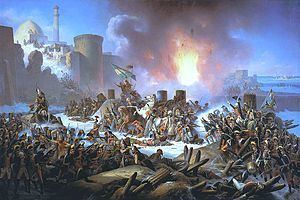Period 1787 – 1792 | ||
 | ||
Combatants Similar Russo‑Turkish War (1806–1812), Siege of Izmail, Battle of Rymnik, Siege of Ochakov, Battle of Focșani | ||
The Russo–Turkish War of 1787–1792 involved an unsuccessful attempt by the Ottoman Empire to regain lands lost to Russian Empire in the course of the previous Russo-Turkish War (1768–74). It took place concomitantly with the Austro-Turkish War of 1787–91.
Contents
Background
In May and June 1787, Catherine II of Russia made a triumphal procession through New Russia and the annexed Crimea in company with her ally, Holy Roman Emperor Joseph II. These events, the rumors about Catherine's Greek Plan and the friction caused by the mutual complaints of infringements of the Treaty of Küçük Kaynarca, which had ended the previous war, stirred up public opinion in Constantinople, while the British and French ambassadors lent their unconditional support to the Ottoman war party.
War
In 1787, the Ottomans demanded the Russians to evacuate the Crimea and give up its holdings near the Black Sea. This was the casus belli as for why the Russians would declare war soon after. On 19 August 1787, war was declared by Russia, and the Russian ambassador to the Ottomans, Yakov Bulgakov, was thrown into prison, consequently, Ottoman preparations were inadequate and the moment was ill-chosen, now that Russia and Austria were in alliance.
The Ottoman Empire opened their offensive with an attack on the two fortresses near Kinburn, in southern Ukraine. Russian General Alexander Suvorov held off these two Ottoman sea-borne attacks in September and October 1787, thus securing the Crimea. In Moldavia, Russian troops captured the Ottoman cities of Chocim and Jassy. Ochakov, at the mouth of the Dnieper, fell on 6 Dec 1788 after a six-month siege by Prince Grigori Potemkin and Suvorov. All civilians in the captured cities were massacred by order of Potemkin.
Although suffering a series of defeats against the Russians, the Ottoman Empire found some success against the Austrians, led by Emperor Joseph II, in Serbia and Transylvania.
By 1789, the Ottoman Empire was being pressed back in Moldavia by Russian and Austrian forces. To make matters worse, on 1 August the Russians under Suvorov attained a victory against the Ottomans led by Osman Pasha at Focsani, followed by a Russian victory at Rymnik (or Rimnik) on 22 September, and drove them away from near the Râmnicul Sărat river. Suvorov was given the title Count Rymniksky following the battle. The Ottomans suffered more losses when the Austrians, under General Gideon E. von Laudon repelled an Ottoman invasion of Bosnia, while an Austrian counterattack took Belgrade.
A Greek revolt, which further drained the Ottoman war effort, brought about a truce between the Ottoman Empire and Austria. Meanwhile, the Russians continued their advance when Suvorov captured the reportedly "impenetrable" Ottoman fortress of Ismail at the entrance of the Danube, in December 1790. A final Ottoman defeat at Machin, (9 July, 1791) coupled with Russian concerns about Prussia entering the war, led to a truce which was agreed upon on 31 July 1791. After the capture of the fortress, Suvorov marched upon Constantinople (present-day Istanbul), where the Russians hoped they could establish a Christian empire. However, as Prof. Timothy C. Dowling states, the slaughters that were committed in the ensuing period somewhat defiled Suvorov's reputation in many eyes, and there were allegations at the time that he was drunk at the siege of Ochakov. Persistent rumors about his actions were spread and circulated, and in 1791 he was relocated to Finland.
Aftermath
Accordingly, the Treaty of Jassy was signed on 9 January 1792, recognizing Russia's 1783 annexation of the Crimean Khanate. Yedisan (Odessa and Ochakov) was also ceded to Russia, and the Dniester was made the Russian frontier in Europe, while the Russian Asiatic frontier—the Kuban River—remained unchanged. The Ottoman war goal to reclaim the Crimea had failed, and if not for the French Revolution, the Ottoman Empire's situation could have been much worse.
